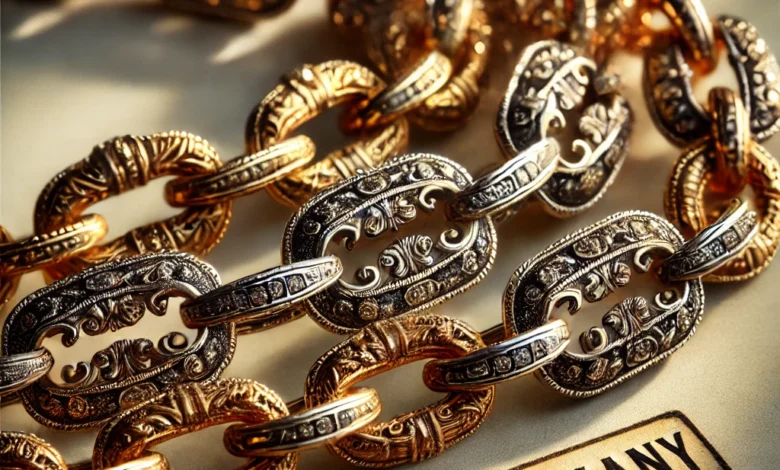Chain Jewelry Stamped “Western Germany”: A Guide to Vintage Elegance

Vintage chain jewelry stamped “Western Germany” holds a unique allure, combining historical significance with quality craftsmanship. These pieces offer fashion enthusiasts and collectors the charm of an era that saw the rise of intricate, affordable, and timeless jewelry styles, marked by the “Western Germany” stamp—a signature of authenticity and quality. This guide explores the background, value, identification tips, and styling ideas for Western Germany chain jewelry, as well as how to care for these timeless pieces.
1. History and Origins of Western Germany Jewelry
Jewelry stamped “Western Germany” typically dates between 1949 and 1990, when Germany was divided into East and West after World War II. Western Germany became known for producing well-crafted, elegant, yet affordable costume jewelry, often featuring materials like rhinestones, glass crystals, and metals. This jewelry was accessible to the masses while showcasing skilled craftsmanship, which quickly grew in popularity across Europe and North America.
During this period, Western Germany emerged as a hub for costume jewelry manufacturing, with artisans combining traditional techniques and new influences. The “Western Germany” stamp became synonymous with intricate designs and durability. This style of jewelry represents a piece of history, capturing the post-war period’s resilience and innovation.
2. Design and Craftsmanship: What Makes Western Germany Jewelry Special
The unique appeal of Western German chain jewelry lies in its remarkable craftsmanship and materials, even though it was designed to be affordable costume jewelry. Here are some of the key design elements commonly found in chain jewelry stamped “Western Germany”:
- Detailed Chainwork: Western Germany chains often feature intricate link patterns and delicate metalwork. Common styles include rope chains, snake chains, and figaro links, which are lightweight but highly durable.
- Crystal and Rhinestone Embellishments: Many pieces feature crystals or rhinestones, giving the jewelry an elegant, luxurious look. Stones are often cut and placed with precision, enhancing the sparkle and shine.
- Textured Metal Finishes: Western German pieces sometimes incorporate textured metals, such as brushed gold or silver finishes, providing a unique visual appeal.
- Filigree and Florals: Floral and filigree patterns are typical in these pieces, reflecting mid-century aesthetics that were prevalent in post-war European fashion.
The combination of these elements makes each piece distinctive and representative of the craftsmanship standards in Western Germany at the time.
Read Also: What is Blacklight Reactive Heat Transfers: A Glow-in-the-Dark Fashion Guide
3. Why Western Germany Jewelry is Collectible and Valuable
Vintage Western German jewelry is increasingly popular among collectors and fashion enthusiasts due to its unique design, quality, and historical significance. Here’s why it’s highly valued today:
- Historical Value: The “Western Germany” stamp captures a distinct period in European history, making each piece more than just an accessory. For many collectors, these items represent a blend of artistry and historical context.
- Rarity and Quality: As fewer pieces remain in circulation, their value tends to increase over time. Each piece was crafted with an attention to detail that makes it stand out, and as these items become harder to find, their collectible status continues to grow.
- Aesthetic Appeal: Western German chain jewelry pieces often reflect the Art Deco, mid-century modern, and even Victorian influences of the time, making them versatile additions to any wardrobe. The aesthetic appeal of this jewelry contributes to its longevity in fashion.
4. Identifying Authentic Western Germany Chain Jewelry
Authenticity is key when collecting vintage jewelry, especially for pieces stamped “Western Germany.” Here’s how to identify genuine Western German chain jewelry:
- Stamped Markings: Authentic pieces will be stamped with “Western Germany” or “W. Germany,” typically on the clasp or back of the piece. This mark is crucial in verifying the item’s origin.
- Materials: Most genuine pieces use high-quality costume materials like gold-tone or silver-tone metals, glass crystals, and rhinestones. These materials add a distinct shine and durability.
- Design Consistency: True Western German chain jewelry has a characteristic design style, often lightweight yet intricately detailed. The craftsmanship of the links and the quality of stone settings help to authenticate these pieces.
When purchasing vintage jewelry online or in stores, always examine these details closely. Buying from reputable sellers or dealers specializing in vintage jewelry can also help ensure authenticity.
5. Caring for Your Western Germany Chain Jewelry
Proper care can preserve the beauty and longevity of your Western Germany chain jewelry. Here are some tips to ensure your pieces remain in excellent condition:
- Avoid Moisture: Keep your jewelry dry, as exposure to water and humidity can damage the metal and loosen stones. Store jewelry in a dry, cool environment.
- Clean Carefully: Use a soft, lint-free cloth to wipe the jewelry gently after each wear, especially if it has rhinestone or crystal elements. Avoid using harsh chemicals or abrasive materials that could damage the finish.
- Store Separately: To prevent scratches or tangling, store each piece in a separate cloth pouch or jewelry box compartment. Keeping your jewelry away from direct sunlight and moisture will also help prevent tarnishing.
Following these care guidelines will help preserve your Western Germany jewelry and keep it looking beautiful for years to come.
6. Styling Ideas for Western Germany Chain Jewelry
Western Germany chain jewelry offers a unique, vintage-inspired look that can be styled in various ways. Here are some ideas to help you incorporate these pieces into modern outfits:
- Layered Chains: Western German chains often feature unique link patterns that work well in layered styles. Pair several chains of different lengths for a trendy layered look.
- Statement Pieces: Many Western German chains are delicate yet eye-catching, making them great for adding vintage charm to a simple outfit, like a plain dress or blouse.
- Mixed Metals: Some Western German jewelry combines gold- and silver-tone finishes, allowing you to wear these chains with both gold and silver accessories for a mixed-metal style.
- Casual and Formal Flexibility: Western German chain jewelry can be dressed up for formal events or worn casually for a subtle vintage touch. Pair a statement chain necklace with an evening dress, or wear a more understated piece with a casual top for everyday elegance.
7. Where to Find Western Germany Chain Jewelry
If you’re interested in adding Western Germany-stamped jewelry to your collection, here are some places to explore:
- Vintage Shops and Antique Markets: Local antique shops and vintage markets are excellent places to discover genuine Western Germany chain jewelry.
- Online Marketplaces: Websites like Etsy, eBay, and other specialty vintage sites often carry a range of Western Germany jewelry pieces. Be sure to verify the seller’s reputation and authenticity.
- Estate Sales and Auctions: Estate sales often feature high-quality vintage pieces, including Western Germany jewelry, at affordable prices.
Shopping at these places can yield unique finds that you won’t come across in standard retail stores, allowing you to build a unique collection.
8. Conclusion: The Enduring Appeal of Western Germany Chain Jewelry
Chain jewelry stamped “Western Germany” remains popular for its historical roots, quality craftsmanship, and distinctive design. Each piece tells a story of a unique era in jewelry production and German craftsmanship, making it more than just an accessory—it’s a piece of art and history. Whether you’re a collector, a vintage jewelry enthusiast, or someone looking to add a touch of elegance to your wardrobe, Western Germany jewelry offers a timeless option that brings both beauty and history to your collection.
